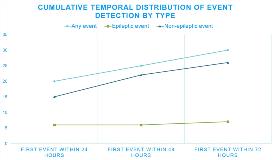The Diagnostic Utility of Ambulatory EEG Following Non-Diagnostic Epilepsy Monitoring Unit Admissions
Abstract number :
1.146
Submission category :
3. Neurophysiology / 3C. Other Clinical EEG
Year :
2018
Submission ID :
479477
Source :
www.aesnet.org
Presentation date :
12/1/2018 6:00:00 PM
Published date :
Nov 5, 2018, 18:00 PM
Authors :
Jonah Fox, Medical University of South Carolina; Shaun Ajinkya, Medical University of South Carolina; Pramod Chopade, Medical University of South Carolina; and Sarah Schmitt, Medical University of South Carolina
Rationale: Epilepsy monitoring unit (EMU) admissions have been demonstrated to provide a definitive diagnosis for approximately three quarters of patients. However, a significant percentage of patients do not receive a definitive diagnosis following an EMU admission. Ambulatory EEG following non-diagnostic EMU admissions was evaluated as a means of providing a diagnosis for these patients. We also evaluated the length of time it would take to obtain a diagnosis by 24-hour intervals. Methods: In this retrospective study we performed a chart review of 62 pediatric and adult patients who had a 72-hour ambulatory EEG following a non-diagnostic EMU admission from May 2015 to May 2017. Information collected included demographic data, time elapsed from start of ambulatory EEG to event, comorbid psychiatric, somatoform and neurological disorders, categorization of event as epileptic or non-epileptic, presence of interictal discharges, number of prior EMU admissions, pre-EMU diagnosis and post-EMU diagnosis. All EEGs were interpreted by board certified neurophysiologists at our tertiary care medical center. Results: In total, there were 62 patients with non-diagnostic EMU admissions who subsequently underwent ambulatory EEG. 41 (66.2%) were female and 46 (74.2%) were adult. Mean age was 33.8 (SD 18.5) and 50 (80.7%) had additional comorbid neurological, somatoform or psychiatric diagnoses. Of the original 62, 32 (51.6%) had no events, 3 (4.8%) had epileptic and non-epileptic events, 4 (6.5%) had epileptic events only, and 23 (37.1%) had non-epileptic events (NEE) only. Ambulatory EEG thus provided a diagnosis in 30 (48.4%) of cases, with 20 (66.7%) of these reached in 24 hours. Conclusions: Ambulatory EEG following a non-diagnostic EMU admission may provide a diagnosis in approximately half of all patients. In two-thirds of those patients, an event occurred within the first 24 hours of the recording. Moreover, 77% of the events that were captured in this setting were non-epileptic. A substantial portion of the non-epileptic patients had an underlying psychiatric or somatoform diagnosis. We hypothesized that this may reflect the presence of provoking psychological stressors in the home environment that may be absent in the EMU setting. Funding: None

.tmb-.jpg?Culture=en&sfvrsn=1d9121da_0)